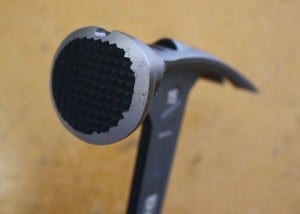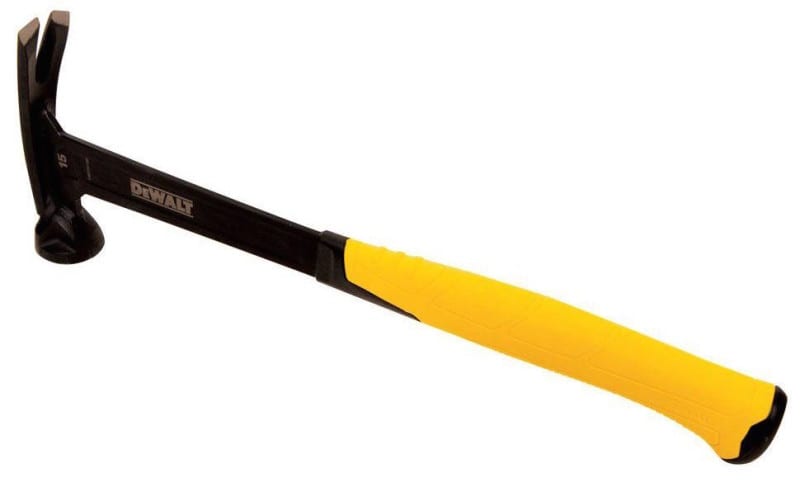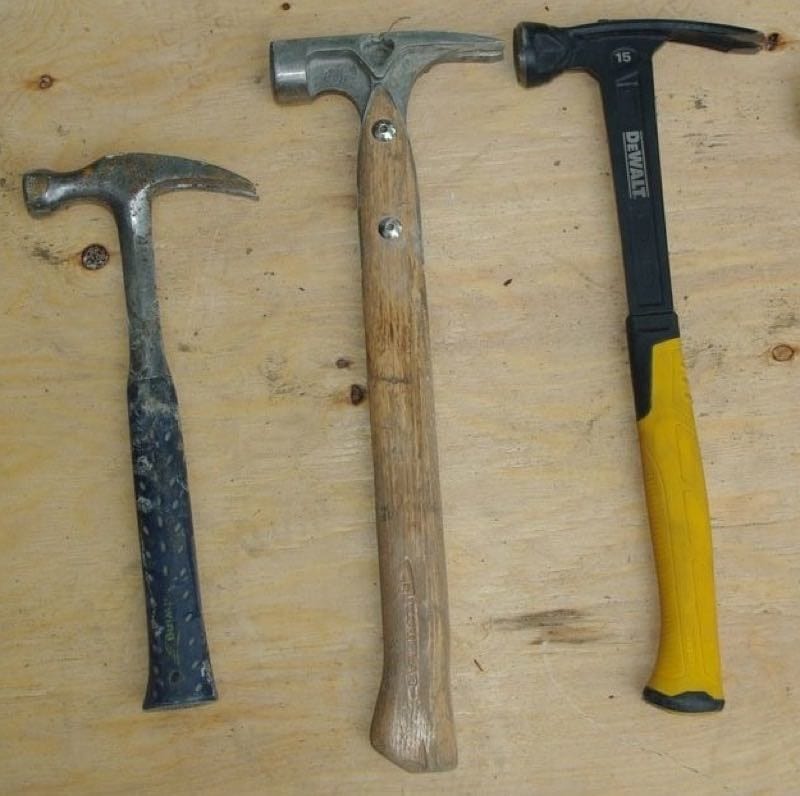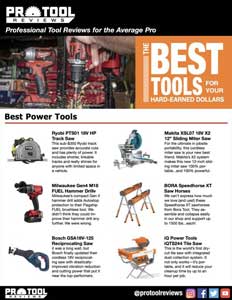In a world of one-piece forged and machined hammers, the new DeWalt DWHT51138 MIG Weld Framing Hammer brings a new way of building hammers to the table. The face, claw and handle are actually separate pieces of forged steel that are permanently joined together. The benefit of the three different pieces is that they can be individually heat-treated for the properties that are required.
Also, by shaving off some of the extra weight and mass, DeWalt is claiming that this hammer swings like a 15-ounce hammer, but hits like a 28 ouncer. We find this to be similar to the claims that we have seen from manufacturers of titanium hammers. While we like the looks of this new hammer, we wanted to know if it could stand up to real job site use and if the lightweight-extra power claim could prove itself in the field.
Editor’s Note: Check out our best framing hammer article for our top picks!
DeWalt DWHT51138 MIG Weld Framing Hammer Features
Visually, the overall design of the Mig Weld hammer is rather conventional. There is an oversized 2″ round waffle-faced striking surface and the top edge of the hammer face features a groove that terminates into a magnet for hands-free nail starting. The claw is nearly straight and the handle is 16″ long with a vibration-absorbing grip. one of the key features of the DWHT51138 15oz MIG Weld Framing Hammer is that it shaves weight by eliminating unneeded bulk in the head.
DeWalt’s approach was to use three separate pieces of forged steel that are then MIG welded together. The idea is that the claw, the face, and the handle all need different mechanical properties to ensure long life and user comfort. The face, for example, needs to be hard and tough enough to allow repeated strikes against nails. The claw needs to be rigid but not brittle so that when you are prying it won’t crack or snap. Conversely, the handle needs to absorb shock by providing just a little bit of flexibility.
Since each of these components require a different heat-treating process to obtain their final mechanical properties, the idea was born to make each piece separate. Then all that remained was to heat treat them individually and MIG weld them together into a cohesive tool. The reason that MIG welding was chosen is that high-quality welds can be produced very rapidly with automatic machinery. Considering we’d like to not pay double for this hammer, nor see consumers having to do so, this was a good call.
DeWalt DWHT51138 Framing Hammer Testing and Use
So how do you best test a framing hammer? Simple. You put it in the hands of a competent framer. The first project that the DeWalt DWHT51138 15oz MIG Weld Framer was used on was the construction of wood forms for a custom concrete project. These were not your regular metal concrete forms, but rather the hand-built variety used to construct a raised patio and stairway for a custom home in Alaska. There was an incredible amount of bracing and plywood nailing – not to mention a bit of tricky planning that went into the project.
At first glance, the DeWalt DWHT51138 MIG Weld Framing Hammer looks much like other hammers until you go to pick it up. With the hammer in your hand, it definitely has a head weight that is less than other similarly sized framers. When we asked about how the head weight was calculated, a product manager at DeWalt informed us that if you were to simply cut the head off at the first diagonal line in the handle below the head, it would weigh in at 15 ounces. The rest of the mass comes from the handle to give a total weight of 28 ounces.
We thought this was kind of ironic given the claim that the hammer has 28 ounces of hitting power. It just turns out that not all that weight is at the business end of the tool. Out on the job we swing various hammers, including a steel 21-ounce Douglas hammer, a 16-ounce titanium Dalluge, and a 16-ounce steel Estwing hammer. For comparison, the total weight of the Douglas is 27 ounces and the titanium Dalluge weighs in at just 22 ounces.
In comparing these hammers, we can’t say the DeWalt felt like we were swinging a 15-ounce hammer – at least not exactly. When it was slung in our tool belt, the weight didn’t feel that much different that any other steel-handled hammer. But to its credit, the DeWalt hammer did a great job of sinking concrete stakes into the ground and driving 16D nails.
When compared to a wood-handled titanium-headed model, the titanium hammer still wins for its ease of nail driving, But when we compare the DeWalt to other steel-handled framing hammers, the MIG Weld does seem to have an edge over the competition. When swinging the DeWalt DWHT51138, the head is noticeably lighter than a similar one-piece forged steel hammer and we felt that the amount of effort required to sink nails was considerably less.
Conclusion
Hammers are like cars. You’re going to have and slowly develop you own taste over time – if you haven’t already. Still, there are those opportunities to look over the fence and check out what the neighbor is driving. That happened a lot this past week during our use of this hammer. Lot’s of people took it for a test drive.
With that said, there’s no dispute that the new DeWalt DWHT51138 15oz MIG Weld Framing Hammer is cool looking and grabs your attention. With an interesting take on an ancient tool, we commend the project managers at DeWalt for their innovation. As far as the claim that it swings like a 15 ounce and hits like a 28 ounce, there is some truth in it, but much of it is user perception and not necessarily to be taken as a scientific statistic.
We did have plenty of fun doing side-by-side comparisons and found, for the users of solid steel hammers, that this is a great alternative. Our guess is that if you are a titanium hammer user, you probably won’t jump ship at this point to go back to steel (unless, of course, you’re looking to save money). But steel users are going to be curious and should give it a swing. From our experience using the tool, we are pretty confident that the new DeWalt MIG Weld framing hammer will get the job done and take many years of abuse.









I prefer this hammer over my wood handled siletto titan and all titanium ti-bone. I think it out-hits the stilettos, feels WAY better in hand than the tibone, and you dont feel wierd abusing it as opposed to the stilettos. The ti-bone has the side nail puller which is awesome. The dewalt flexes when using it to pull nails laterally which isnt so hot buy i havent put any permanent bend in it. If it is laying on the ground and you step on it, the handle will bend and touch the ground. Again, it flexes back to true –… Read more »